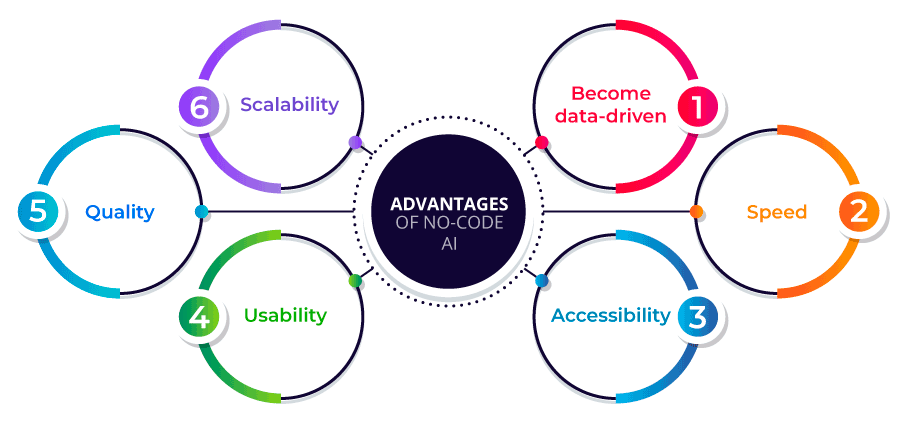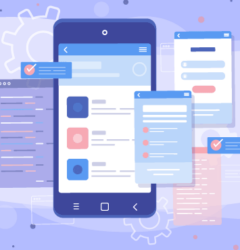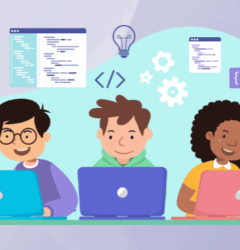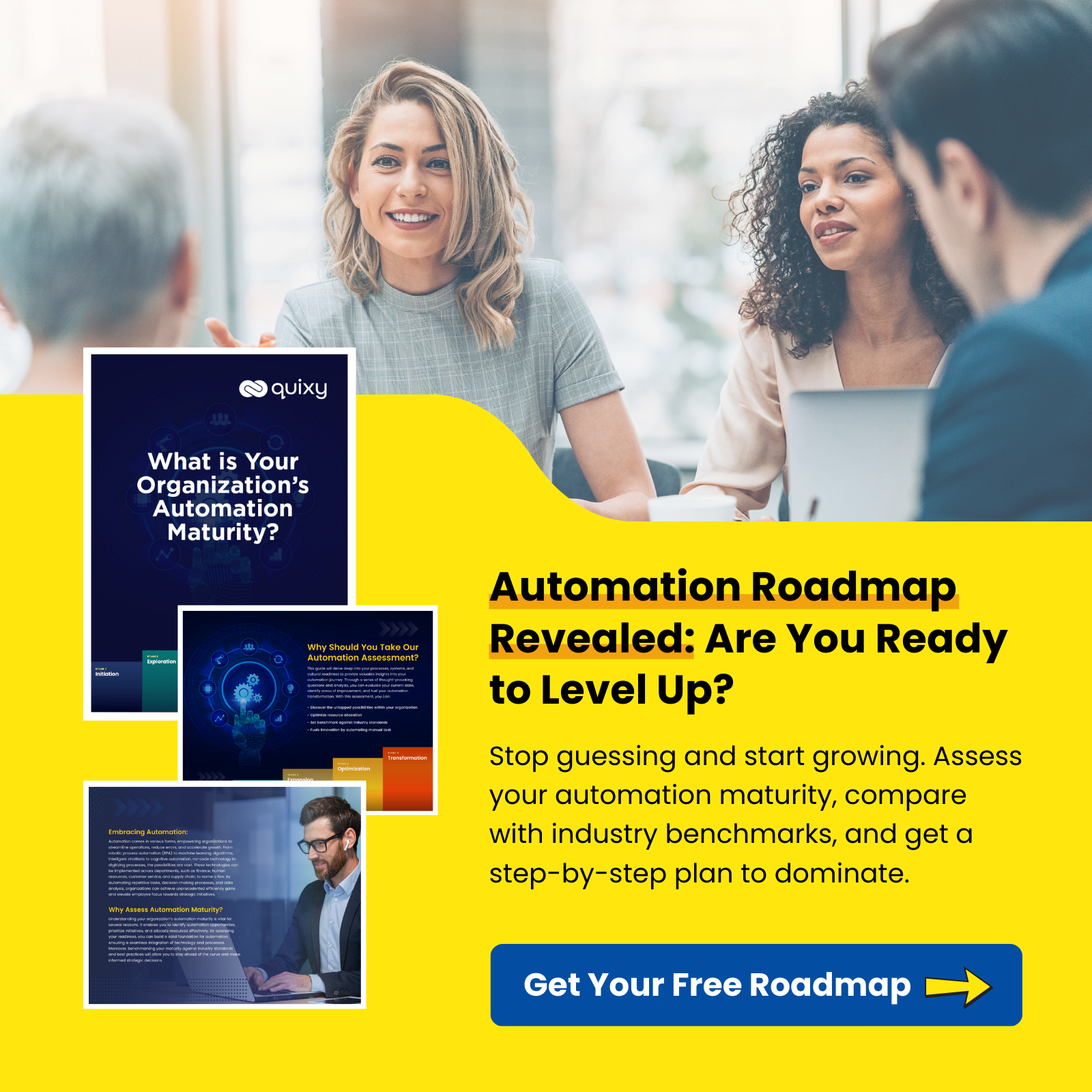
Over the last few decades, AI-artificial intelligence has rapidly grown, becoming vital to a wide range of industry sectors. With the advances in Artificial intelligence architectures such as Generative AI, Conversational AI, and Hybrid AI, traditional corporate operations have been revolutionized, promoting increased efficiency, flexibility, and productivity. This article we are exploring the Depths: Unveiling AI Models and Their Applications with the Perfect Combo of No-Code Technology.
Advances in Artificial Intelligence
Artificial Intelligence (AI) is reshaping the world with its groundbreaking architectures. In our latest blog, we dive into three game-changing AI advancements: Generative AI, Conversational AI, and Hybrid AI. Generative AI unleashes the creative power of machines, enabling them to produce realistic art, videos, and even write captivating stories. Conversational AI brings us closer to human-like interactions with chatbots and virtual assistants that understand and respond to our queries and emotions. Lastly, Hybrid AI combines the strengths of different AI approaches, delivering robust and adaptable solutions to complex problems. Join us in exploring these remarkable AI architectures that are revolutionizing industries and transforming our daily lives. Read more on our blog now!
Also Read: AI Revolution: Top 60 Statistics and Predictions
Generative AI: Delving Deeper into the Realm of Synthetic Creativity
Generative AI, at its core, refers to a subclass of machine learning models whose primary purpose is to produce unique data instances that reflect the features of the original or training data. These AI models use a variety of complex approaches, such as:
- statistical mechanics,
- pattern recognition,
- predictive modeling,
To draft content in a wide range of disciplines, from images and text to music and beyond.
The most powerful torchbearer of Generative AI is the concept of Generative Adversarial Networks (GANs), introduced by Ian Goodfellow & his colleagues. This AI advanced model brings together two neural networks: a generator and a discriminator. As the name implies, the generator generates new data instances, while the discriminator, trained on real data, evaluates the authenticity of these generated data. This continuous ‘game’ of fooling and detecting ultimately allows the generator to produce data that are remarkably similar to the original.
DeepArt, an online tool that recreates user-uploaded images in the style of world-renowned artists such as Van Gogh or Picasso, is a popular and straightforward use of Generative AI. It makes use of style transfer models, a type of GAN. These models learn the particular aesthetic style of a given artwork and apply it to a different image, resulting in a new piece of art that replicates the original artwork’s stylistic quirks.
Furthermore, music composition has also benefited from Generative AI. OpenAI’s MuseNet, a deep learning model, is capable of generating 4-minute musical compositions with 10 different instruments, covering styles from Baroque to the Beatles, further broadening the horizon for Generative AI applications.
Also Read: Staying Ethical in the AI Era: A Data-Driven Guide
In addition to these creative realms, Generative AI is used to generate synthetic data to address privacy problems. Companies such as Mostly AI offer solutions that generate synthetic datasets that are similar to the real ones but do not pose any privacy risks. This is especially useful in industries such as healthcare, where AI privacy concerns frequently hinder data use.
The prowess of Generative AI was aptly demonstrated in a research study conducted by NVIDIA. They developed a GAN named StyleGAN that was able to fabricate hyper-realistic, high-resolution images. The generated images were so authentic-looking that they managed to trick human evaluators into believing they were actual photos. This highlights the potential of Generative AI to mimic the real world and create entirely different realities.
Generative AI is creating unparalleled opportunities in both the digital and physical worlds. Whether it’s bringing an artist’s style to life, writing symphonies, or creating synthetic data for study, these models are constantly pushing the limits of what we think is possible in the field of artificial intelligence.
Also Read: 15+ ChatGPT Prompts Tips to get the best results
Conversational AI: An Interface for Human-AI Interactions
Conversational AI is a popular subset of AI that is primarily developed to help machines understand, process, and reply to human language as naturally and efficiently as possible. This technology can perceive and convey human language by incorporating advanced algorithms from Natural Language Processing (NLP), Machine Learning (ML), and Deep Learning (DL).
NLP allows the computer to analyze the structure and meaning of human language; ML allows the machine to learn from data, and DL, a subset of ML, processes data using neural networks with multiple layers (thus, ‘deep’). These components work together to improve a machine’s capacity to decode and respond to user input, closely resembling human-like communication.
Conversational AI relies on important models such as chatbots and voice assistants, which are increasingly common in our daily lives. They use the technology’s key parts to comprehend user inputs, decipher their context, construct appropriate replies, and learn from each contact. This feature of continuous learning helps improve the quality of future encounters, increasing the entire user experience.
Also Read: Power of AI for everyone with ‘No-Code AI’
Chatbots, for instance, have found applications in various fields, such as customer service, where they handle inquiries and provide immediate responses. Brands like Sephora employ chatbots on their websites and social media pages to offer personalized product recommendations, fostering a more engaging and efficient customer experience.
Voice assistants such as Amazon’s Alexa, Apple’s Siri & Google Assistant also harness Conversational AI. They assist users in numerous tasks, ranging from setting alarms and playing music to answering trivia and controlling smart home devices. Recognizing and understanding the user’s voice commands creates a seamless, hands-free user experience.
- OpenAI’s GPT-3 model, a state-of-the-art example of Conversational AI, is distinguished for its text generation capabilities and nuanced language understanding.
- Beyond writing emails or translating languages, GPT-3 can engage in complex tasks such as creating human-like poetry, drafting legal contracts, generating Python code, and even tutoring in various subjects.
- It achieves this by predicting the likelihood of a word given the previous words used in the text. Trained on an extensive range of internet text, GPT-3 has been able to generate impressively coherent and contextually relevant text.
Conversational AI’s future seems bright as we continue to hone and refine these systems. This technology will continue to change our relationship with machines, making it more natural and intuitive, whether it is assisting in customer service, assisting in daily tasks, or creating sophisticated texts.
Also Read: The Role of Generative AI and ChatGPT in the Digital Workplace
Hybrid AI: Harnessing the Best of Both Worlds – Extended View
In the artificial intelligence environment, hybrid AI, a novel combination of rule-based systems and machine learning models, is making significant waves. In contrast to traditional AI systems, which depend primarily on data-driven machine learning or predefined rules, Hybrid AI integrates two approaches to build a more powerful and versatile learning framework.
The true strength of Hybrid AI comes in its capacity to learn and grasp massive volumes of data via machine learning while still adhering to human-specified standards to ensure accuracy and explanability. This balance of rules and learning gives the system a one-of-a-kind combination of adaptability and stability, allowing it to tackle complicated tasks with increased efficiency and predictability.
Also Read: Everything you should know about No-Code Development

Let’s dissect this further. Rule-based components allow the system to deal with domain-specific knowledge and make logical deductions, reducing reliance on large amounts of data. In contrast, machine learning components allow the system to adapt based on data and improve performance over time, offering the flexibility to deal with uncertainties and novel situations. This amalgamation of the deterministic (rule-based) and the probabilistic (machine learning) paves the way for a more robust AI system.
- Consider the widely recognized real-world implementation of Hybrid AI: IBM’s Watson. Watson represents a significant leap in AI technology, especially in the healthcare sector.
- It combines rule-based reasoning, which offers a methodical approach to interpreting medical literature and clinical guidelines, with machine learning, allowing it to learn from previous patient data and improve its diagnostic and treatment recommendation abilities over time.
- Watson’s cognitive computing technology has made a considerable impact in oncology. By ingesting millions of pages of medical literature and patient data, it can suggest potential diagnoses and recommend personalized treatment plans. This system assists physicians by providing evidence-based treatment options while accommodating individual patient differences.
Also Read: Caddie by Quixy: The AI Assistant Empowering Smarter Decisions
This Hybrid AI’s effectiveness was demonstrated in a study published in ‘The Oncologist.’ Watson achieved an impressive 93% agreement rate with a multidisciplinary tumor board’s recommendations for lung cancer treatment. This strong concurrence not only reaffirms the technological prowess of Hybrid AI but also illustrates its potential role in enhancing healthcare delivery.
In addition to healthcare, Hybrid AI has applications in a variety of other fields. Palantir’s predictive police solution incorporates rule-based systems to ensure compliance with legal and policy limits and machine learning to forecast crime hotspots. Similarly, organizations like ZestFinance use Hybrid AI models to evaluate loan applications in financial technology. The models are trained using ML approaches while adhering to regulatory requirements, lowering risks and bias in decision-making.
Hybrid AI is a promising area in artificial intelligence because it combines the strengths of rule-based systems and machine learning. It has the potential to influence a range of industries, from healthcare and law enforcement to finance and beyond, enriching our technological landscape with its unique blend of accuracy, interpretability, and scalability.
Also Read: AI Automation 101: What It Is & How Businesses Are Using It
Synergy of Advances in AI and No-Code Development

Advances in Artificial Intelligence (AI) have unlocked the power of generative, conversational, and hybrid AI models, and when combined with the emerging trend of no-code development, the possibilities become even more exciting. Generative AI models, such as GPT-3, can create human-like text, images, and even music, opening up a world of creative possibilities for content generation. Conversational AI models, like chatbots & virtual assistants, are becoming more sophisticated in understanding and responding to human language, enhancing customer service and support experiences.
Hybrid AI models combine the strengths of multiple AI skills and techniques, such as combining deep learning with symbolic reasoning, to tackle complex problems. The integration of these advanced AI capabilities with no-code platforms allows individuals without coding expertise to harness the power of these models and build intelligent applications effortlessly. This powerful duo democratizes AI, enabling a wider range of people to leverage its potential and drive innovation across industries.
Conclusion
The rapid strides in AI research are gradually unveiling the immense potential of Generative AI, Conversational AI, and Hybrid AI. These technologies are progressively reshaping how we interact with machines, generate new data, and leverage AI’s learning capabilities to solve complex problems. With ongoing advancements and research, AI is destined to continue its journey of exploration and revolution. Also, AI enhances the skills of citizen developers by automating intricate tasks, freeing them to concentrate on the creative facets of application development.
Frequently Asked Questions (FAQs)
Q. How advanced is AI currently?
AI has seen remarkable advancements in generative, conversational, and hybrid models. Generative AI, like GPT-3, can produce human-like text and creative content. Conversational AI, including chatbots and virtual assistants, enhances customer experiences. Hybrid AI combines various techniques for complex problem-solving. The integration of these advanced AI models with no-code technology empowers non-coders to leverage their potential. This combination democratizes AI, making it accessible to a wider range of individuals. With no-code platforms, users can harness the power of generative, conversational, and hybrid AI without extensive coding knowledge. This synergy is driving innovation across industries and transforming the way we create and deploy intelligent applications.
Q. What are the recent AI advances revolutionizing industries?
Q. How advanced is AI currently?
AI has seen remarkable advancements in generative, conversational, and hybrid models. Generative AI, like GPT-3, can produce human-like text and creative content. Conversational AI, including chatbots and virtual assistants, enhances customer experiences. Hybrid AI combines various techniques for complex problem-solving. The integration of these advanced AI models with no-code technology empowers non-coders to leverage their potential. This combination democratizes AI, making it accessible to a wider range of individuals. With no-code platforms, users can harness the power of generative, conversational, and hybrid AI without extensive coding knowledge. This synergy is driving innovation across industries and transforming the way we create and deploy intelligent applications.
Q. How do AI and no-code synergy empower non-coders?
The synergy of AI and no-code empowers non-coders by providing visual interfaces and drag-and-drop components to build AI-powered applications. This eliminates the need for extensive coding expertise & knowledge, enabling individuals to leverage AI capabilities for tasks like automation, data analysis, and predictive modeling.
Q. What are the practical applications of generative, conversational, and hybrid AI in no-code development?
In no-code development, generative AI enables content creation, such as generating text, images, or music. Conversational AI powers chatbots and virtual assistants for customer support and interaction. Hybrid AI combines multiple techniques for complex problem-solving, addressing tasks like data extraction or sentiment analysis.
Q. How does no-code integration democratize AI?
No-code integration democratizes AI by making it accessible to a wider audience. It eliminates the dependency on specialized data scientists or developers, enabling business analysts and domain experts to leverage AI’s potential for decision-making, automation, and process optimization.
Q. What are the benefits of combining AI and no-code for businesses and individuals?
Combining AI and no-code brings several benefits for businesses and individuals. It enhances productivity by enabling rapid prototyping and experimentation, leading to faster application development. It also facilitates innovation by allowing non-technical individuals to leverage AI’s power and build intelligent solutions. Additionally, the democratization of AI through no-code empowers individuals to make data-driven decisions, improve efficiency, and create personalized experiences, ultimately driving growth and competitive advantage.
Subscribe
Login
Please login to comment
0 Comments
Oldest
















